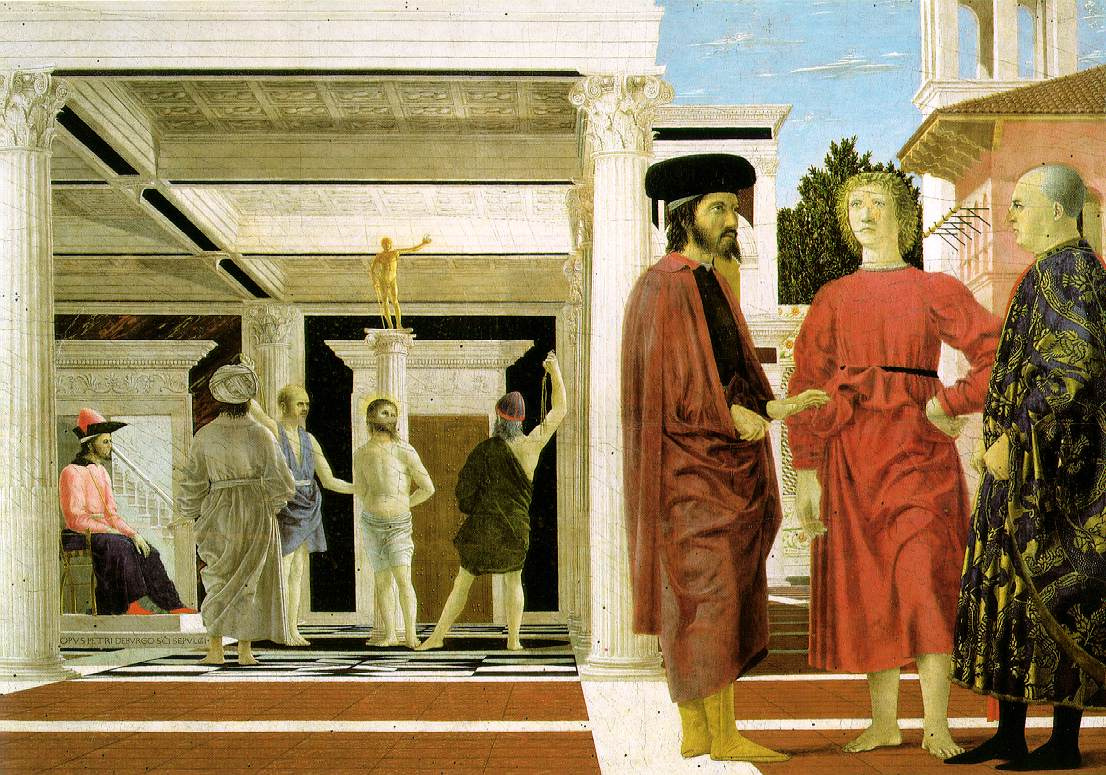log in
Enter site
Login to use Arthive functionality to the maximum
Flagellation Of Christ
Piero della Francesca • 绘画, 1444, 59×82 厘米
画作描述 «Flagellation Of Christ»
Italy, middle of the XV century — a time now called the Early Renaissance. Fine art is just starting to move away from the canons of the middle Ages: the artists are trying to connect, the usual techniques with elements of ancient classics, getting in the end something completely new. They studied mathematics, anatomy, and principles of perspective that allows them to create the most realistic image. Among the innovators, Piero della Francesca, the painter, who never left the thirst for knowledge, the author of the famous painting "Flagellation Of Christ".
This painting attracts attention primarily for its unusual composition close to the diptych. Visually, the painting of Piero della Francesca, "Flagellation of Christ" consists of two parts, which at first glance does not related to each other: the scene of the flagellation is depicted in the left part of the canvas right as the viewer sees a group of three men, quietly conversing among themselves. This combination of cruelty and ordinariness gives the story some drama and makes a fresh look at what is happening.
To visually separate one part from another, the artist uses the reception of linear perspective, placing Christ and his executioners in the depth of the portico. The rhythmic alternation of vertical and horizontal lines that make up the floor, ceiling and pillars, creates around this group a kind of frame, beyond which is the Trinity, clearly oblivious to what is happening behind them. Of all the figures depicted on the canvas, only one is in motion — is the executioner, however the beach.
Like many other works, whose age is several centuries, the painting of Piero della Francesca, "Flagellation of Christ" carries a lot of mysteries, which are still fighting critics around the world. Why the artist chose this composition? Who are those three standing right in the foreground? Is the character sitting on a throne and watching the scourging, the image of Pontius Pilate or is it the other person? To date, there are several answers to these questions.
The traditional description of the paintings of Piero della Francesca, "Flagellation of Christ" States: three men on the right side — it is the Duke da Montefeltro, next to which are his two counselors. Because of the ill actions of the advisers, the citizens were dissatisfied with the reign of Duke that led to the emergence of a conspiracy against him and the subsequent murder. According to critics, the Duke himself presented as innocent victims, as evidenced not only by its "neighborhood" with stage is one of the Passions of Christ, but: bare feet, a simple dress, a wreath on his head.
Another version claims that the two companion of the Duke's advisers, and his killer. With regard to the figures on the throne, who often identificeret as Pontius Pilate sentenced Christ to punishment, here the opinions are also divided. In the form of a seated person, the artist could act as the Procurator of Judea, and so John VIII Palaeologus (Byzantine Emperor).
Today, the painting of Piero della Francesca, "Flagellation of Christ" exhibited at the National gallery of Marche (Urbino, Italy) and is one of the gems of the exhibition.
This painting attracts attention primarily for its unusual composition close to the diptych. Visually, the painting of Piero della Francesca, "Flagellation of Christ" consists of two parts, which at first glance does not related to each other: the scene of the flagellation is depicted in the left part of the canvas right as the viewer sees a group of three men, quietly conversing among themselves. This combination of cruelty and ordinariness gives the story some drama and makes a fresh look at what is happening.
To visually separate one part from another, the artist uses the reception of linear perspective, placing Christ and his executioners in the depth of the portico. The rhythmic alternation of vertical and horizontal lines that make up the floor, ceiling and pillars, creates around this group a kind of frame, beyond which is the Trinity, clearly oblivious to what is happening behind them. Of all the figures depicted on the canvas, only one is in motion — is the executioner, however the beach.
Like many other works, whose age is several centuries, the painting of Piero della Francesca, "Flagellation of Christ" carries a lot of mysteries, which are still fighting critics around the world. Why the artist chose this composition? Who are those three standing right in the foreground? Is the character sitting on a throne and watching the scourging, the image of Pontius Pilate or is it the other person? To date, there are several answers to these questions.
The traditional description of the paintings of Piero della Francesca, "Flagellation of Christ" States: three men on the right side — it is the Duke da Montefeltro, next to which are his two counselors. Because of the ill actions of the advisers, the citizens were dissatisfied with the reign of Duke that led to the emergence of a conspiracy against him and the subsequent murder. According to critics, the Duke himself presented as innocent victims, as evidenced not only by its "neighborhood" with stage is one of the Passions of Christ, but: bare feet, a simple dress, a wreath on his head.
Another version claims that the two companion of the Duke's advisers, and his killer. With regard to the figures on the throne, who often identificeret as Pontius Pilate sentenced Christ to punishment, here the opinions are also divided. In the form of a seated person, the artist could act as the Procurator of Judea, and so John VIII Palaeologus (Byzantine Emperor).
Today, the painting of Piero della Francesca, "Flagellation of Christ" exhibited at the National gallery of Marche (Urbino, Italy) and is one of the gems of the exhibition.


